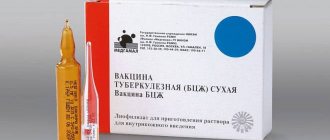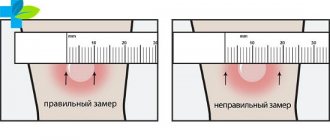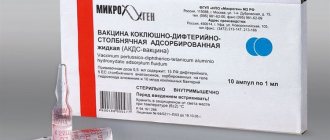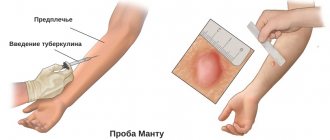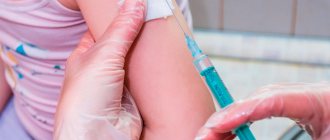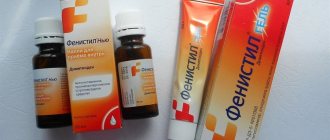Antihistamines and tuberculin test
An antihistamine is a drug that has the ability to reduce the production of histamine. Antihistamines are taken to combat various allergic reactions.
The tuberculin test or Mantoux test is a diagnostic method for detecting the presence of tubercle bacilli in the body. For diagnosis, a special injection containing tuberculin is injected into the skin. This substance is considered an allergen.
Can I eat before the test?
To prepare for Mantoux, you should exclude from your diet some foods that can cause an allergic reaction. These are chocolate, citrus fruits (grapefruit, oranges, limes, tangerines, lemons). In addition, eating before Mantoux is not recommended:
- Marinades and spicy foods. The child should eat less fermented vegetables and sauces. It is not recommended to season dishes with citric acid and add spices, as well as over-salt.
- Canned food and semi-finished products.
- Fatty fish and meats.
- Products that contain a lot of sugar: sweets, cakes, pastries.
- Nuts - peanuts, cashews, hazelnuts, walnuts, which are the strongest allergens.
- Quail and chicken eggs - boiled, raw, in the form of omelettes, scrambled eggs, in baked goods, in dough.
- Fruits and berries - kiwi, avocado, peaches, strawberries, strawberries.
- Seafood - lobster, crab, crayfish. When consuming them, the likelihood of developing allergies increases.
- Vegetables - eggplants, tomatoes, dill, celery, carrots, parsley, which are allergens.
- Sea kale.
- Legumes - beans, soybeans.
- Dairy products - milkshakes, ice cream, cheeses, butter, heavy cream, whole milk.
- Wheat sweet cereals, baked goods made from wheat flour, white bread.
Before preparing for vaccination, you should not drink carbonated drinks or juices containing preservatives. In addition, it is forbidden to eat any food in large quantities and you should refrain from eating new ones. Even if the child does not suffer from food allergies, some foods may trigger a false-positive Mantoux reaction.
It is best to eat the following foods and dishes before Mantoux vaccination:
- porridge;
- low-fat lean soups;
- dried fruits;
- apples;
- poultry and rabbit meat;
- fermented milk products: fermented baked milk, kefir, yoghurts.
Before Mantoux you need to drink still mineral water and fruit drinks. They return to their usual diet after the results of the tuberculosis test are received.
Simultaneous use of antihistamines and Mantoux
Antihistamines with a narrow effect (for example, taking Suprastin, Fenistil or Zyrtec) cannot affect the reaction of the tuberculin test. This is due to the fact that Mantoux triggers other allergic reactions that cannot be affected by these medications.
If a newborn has an allergic reaction, antihistamines should be taken for a week before Mantoux, then stopped five days before the tuberculin diagnosis. After Mantoux, use for two days. This is necessary to eliminate allergies when injecting the sample. But antihistamines should not be abused.
Mantoux - why and when?
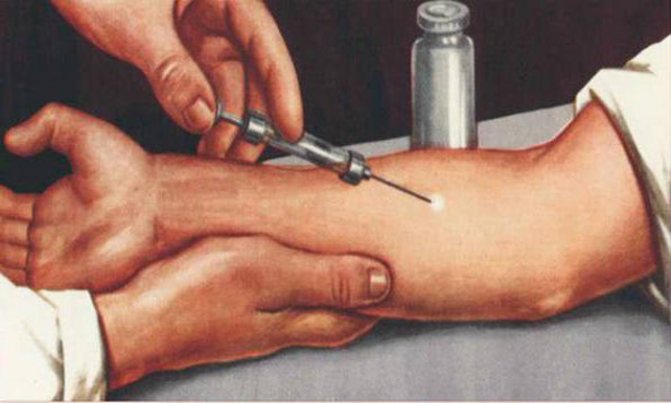
Even in the maternity hospital, a newborn baby is given a BCG vaccination, the purpose of which is to develop immunity against tuberculosis. Why such urgency?
The fact is that the incidence of tuberculosis today is very high; you can encounter the tuberculosis bacillus, the causative agent of the disease, almost everywhere. The gender, age, and social status of people with tuberculosis break the stereotypes that this disease is the fate of disadvantaged sections of the population.
Mycobacterium tuberculosis is highly resistant to external factors, and therefore is able to survive and remain active in the external environment for a long time. And in order to protect a newborn child from infection, they are vaccinated with BCG, designed to develop a stable immunity to tuberculosis in the body.
And when the child reaches the age of 12 months, they begin to evaluate the acquired immunity using the Mantoux test. This measure also helps to identify the presence of tuberculosis in the early stages if infection does occur.
This is one of the few ways in which you can determine the development of tuberculosis at an early stage. After all, the disease begins without the manifestation of any symptoms, and without regular preventive diagnostics, it is possible to determine the disease at a rather advanced stage, which greatly complicates treatment. Therefore, this test should be carried out regularly, usually once a year, and in some cases every six months (for people at increased risk of contracting tuberculosis).
Mantoux is not a vaccine! It will not provoke the disease, nor is it capable of developing immunity to it. With its help you can only check the body's reaction to the pathogen.
So, to conduct the Mantoux test, the child is injected subcutaneously with tuberculin, a drug created from dead mycobacterium tuberculosis. In response, T-lymphocytes accumulate from the blood vessels of the skin at the injection site, but only those who have already “met” the causative agent of the disease, forming a compaction, the so-called papule. If Koch's bacillus is present in the body, there will be many such lymphocytes, and the papule will have an increased size.
The resulting reaction is estimated as:
- negative;
- doubtful;
- positive;
- false positive.
With this diagnostic method, a false negative response is excluded due to the 100% sensitivity of the test.
Since this diagnostic method involves the introduction of a drug into the body, side effects from this procedure cannot be excluded, most often associated with an individual allergic reaction to the drug. Proper preparation for Mantoux will help reduce the risk of such reactions: it is recommended to prepare for the procedure 2-3 days before the appointed date.
Necessary measures for correct readings
In addition to the fact that it is necessary to use antihistamines, the following rules must also be observed:
- Get examined by a pediatrician or phthisiatrician. He will help you decide whether you need to take antihistamines before Mantoux. He will also clarify on what days the test is taken.
- It is necessary to follow a special diet to avoid causing an allergic reaction.
- Before the tuberculin test, it is necessary to measure body temperature. It should not exceed normal.
- Before the tuberculin test, you need to be examined again by a pediatrician.
If you follow all of the above measures, the Mantoux reaction will give the correct results.
How to take antihistamines before performing the Mantoux test
The decision to prescribe a particular drug, including Suprastin, is made by the doctor. He will also tell you about the regimen. However, there are general guidelines that you should follow before using antihistamines.
Regardless of whether the decision is made to take antiallergic medications, it is important to follow the standard rules for preparing for a tuberculin test.
- Visit a pediatrician or TB doctor in advance. The doctor will set a date for the procedure and determine the advisability of antihistamine drug therapy.
- Follow a hypoallergenic diet so as not to provoke the development of an immediate allergic reaction.
- On the day of the scheduled procedure, measure your body temperature. Even a minimal deviation from the normal value is not allowed.
- Immediately before the injection, the patient should be examined by a doctor.
Following these simple rules will reduce the likelihood of developing any negative consequences, including allergies.
Admission rules
To prevent a false positive result, you need to start giving Suprastin before Mantoux in advance and continue taking it for a week. Then you need to take a break - 5 days. This is followed by a test, after which the use of antihistamines continues for two days.
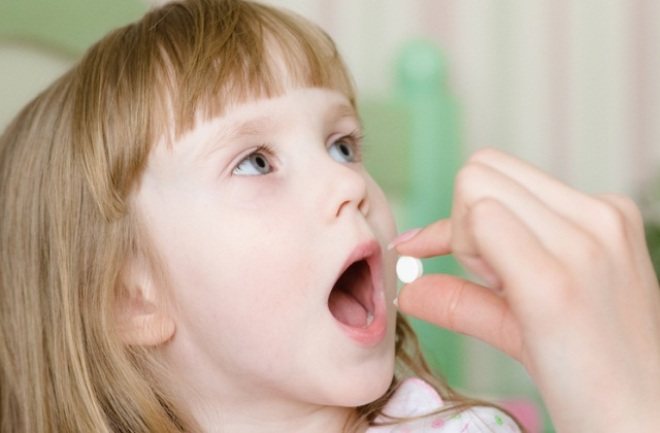
The dosage is shown in the table below.
| Age | Dose | Reception frequency |
| Up to a year | ¼ tablet (as powder) | 2-3 times a day |
| 1-6 years | ¼ tablet; ½ tablet | 3 times a day; 2 times a day |
| 6-14 years | ½ tablet | 2-3 times a day |
Adults are prescribed a whole tablet 3-4 times a day. The daily dose can be increased (for both children and adults), but this requires the absence of side effects. The maximum daily dose is 2 mg per kilogram of patient weight. It cannot be exceeded.
About nutrition
Products that are allergens can distort the results. To prevent this from happening, you should follow some nutritional rules:
- do not eat foods that may cause allergies;
- do not introduce new products to the menu (especially such as soda, chewing gum and others containing complex chemical compounds);
- During the test, exclude potential allergens from the diet - honey, chocolate, citrus fruits, nuts. After checking Mantoux, they can be eaten again;
- diversify your child’s diet and ensure that your child eats healthy foods.
In order for the Mantoux tuberculin test to pass without unpleasant consequences, you should not neglect the recommendations of specialists. If a pediatrician, knowing that a small patient is prone to allergies, prescribes Suprastin before diagnosis, it is better to follow his advice. Then the test will be reliable and will not bring such an unpleasant complication as an allergy. However, each parent decides for himself whether it is necessary to give antihistamines before Mantoux. The main thing is to understand that Mantu and Suprastin are quite compatible.
Nutrition before tuberculin test
To avoid false positive results, which are influenced by allergenic foods, it is necessary to follow a special diet.

To do this, there are the following recommendations for feeding a child:
- You should not eat food to which your child may have an allergic reaction.
- Dishes or ingredients that the mother has not previously given to the baby (especially carbonated drinks, chewing gum and other chemicals). Any new product affects the Mantoux reaction.
- Foods that contain a high concentration of allergens. There is no need to give beekeeping products, nuts, citrus fruits, etc. If you give all of the above, false reactions of the tuberculin test are possible.
- If you give any product, you need to know when to stop. The child's diet should be varied.
What side effects are possible?
From the moment of tuberculin administration until the result is assessed, 72 hours must pass. Usually this period proceeds easily, without any worries. However, in some cases, side effects are possible, so parents need to pay special attention to the child during this period of time and monitor the general condition of the child.
In some cases, there may be unpleasant sensations that can cause discomfort. We are talking about redness and itching of the skin at the site of tuberculin injection, sometimes there is slight swelling of the tissue.
The following reasons cause this reaction:
- individual intolerance to tuberculin, severe allergic reaction to the drug;
- unaccounted for contraindications for the test (the test was carried out against the background of an existing infection, or not enough time has passed since the illness);
- infection through an injection wound (when the test site was subjected to excessive mechanical stress - friction, scratching).
To reduce an excessive allergic reaction, the child can be given an antiallergic drug.
To prevent infection, you need to convince the child not to touch or scratch the injection site. Of course, a teenager will listen to advice in this regard, but if the baby is a year or two old, it is extremely difficult to explain this to him. In this case, an adult needs to pay special attention to the baby to prevent any impact on the hand. Long sleeves will also help with this.
If antiallergic drugs do not help, the symptoms do not go away, but, on the contrary, worsen, the child feels unwell, the temperature rises, the baby complains of pain in the arm on which the test was performed, it is necessary to urgently consult a doctor.
Taking Suprastin before a tuberculin test
To eliminate the risk of an incorrect reaction to the tuberculin test, Suprastin should be taken before Mantoux. As mentioned earlier, an antihistamine is used seven days before the tuberculin test. It is not recommended to take Suprastin for five days.
To detect the presence of a pathogenic microbe (Koch bacillus) or immunity to the tuberculosis bacillus in a child’s body, it is necessary to perform a test. Depending on the result it gives, we can talk about further actions. Tuberculin is an allergen. After injecting it into the skin at the injection site, unique lymphocytes are released from the circulatory system. They are responsible for cell immunity and are also sensitized to the tuberculosis pathogen. Because of this, an inflammatory process begins at the injection site.
Instructions
Suprastin before Mantoux should not be used in the following cases:
- exacerbation of bronchial asthma;
- bearing a fetus;
- breastfeeding;
- prophylaxis cannot be carried out with Suprastin in the form of tablets if the child is under three years old;
- lack of lactose;
- lactose intolerance;
- glucose-galactose malabsorption syndrome;
- hypersensitivity to drug components.
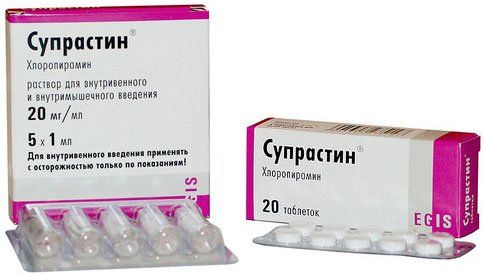
The dosage of drugs for children is as follows:
- for babies under one year of age, 1/4 tablet 2-3 times a day - always in powder form;
- children under six years of age: 1/4 tablet 3 times a day, or half a tablet twice a day;
- for children from six to fourteen years old, half a tablet 2-3 times a day.
Adults can take the drug one tablet 3-4 times a day. The daily norm can be increased for both adults and children, but if there are no side effects. The daily dose should not exceed two milligrams per kilogram of body weight.
When should you not give Suprastin with Mantoux to children?
When performing a Mantoux test, Suprastin cannot be used for children with:
- worsening of bronchial asthma;
- lactose intolerance (milk sugar);
- hypersensitivity to the drug;
- impaired functioning of the kidneys and liver;
- severe diseases of the cardiovascular system.
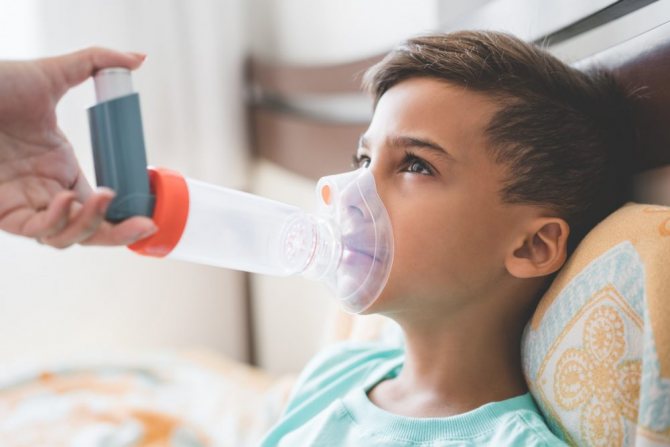
Complications when taking
Usually, the child is most likely to experience drowsiness and lethargy when taking Suprastin. Less common are abdominal pain and headache, dizziness, dry mouth. In young children, appetite changes - it may increase or decrease.
Otseka Mantu
Allergies of a nonspecific nature, which are affected by Suprastin and other antihistamines, appear within a few minutes. It is in this regard that when these drugs are used on the first day, the tuberculin test is weak. But diagnostic indications are checked only three days after the injection. This occurs after a specific cell immune reaction has manifested itself. In this regard, taking antihistamine drugs does not affect the indications.

After the primary vaccination and revaccination with the Calmette-Guerin bacillus, lymphocytes appear in the baby’s body, which for a long time “remember” the pathogenic microbe initiator and are in eternal preparation for the next hit of the Koch bacillus. This is the resistance of the immune system to tuberculosis. The immune response to an infectious bacterium entering the body will be powerful and effective. It can instantly destroy the pathogenic microbe.
Source
Is it necessary to give antihistamines before Mantoux?
Nowadays, more and more children are prone to allergies. In this regard, the doctor may decide on the need to take one or another antiallergic drug.
An antiallergic, or antihistamine, drug is a drug whose pharmacological action is aimed at suppressing the production of histamine. Histamine is an organic compound that mediates immediate allergic reactions.
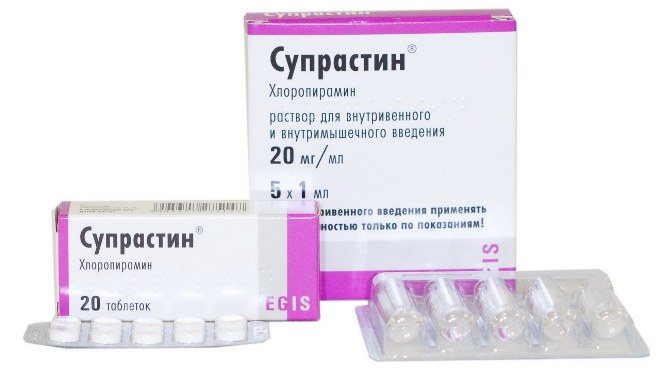
It is important to remember that the medicine is prescribed only by a pediatrician, self-medication is dangerous and can lead to serious consequences, so the question of whether Mantoux and antihistamines are compatible should be asked to a specialist.
To reduce the likelihood of a false-positive result, antihistamines are started a week before the planned test, and then continued for two or three days after it. But you should not exceed prescribed doses and abuse medications.
When not to give medicine
Suprastin has a number of contraindications, including:
- bronchial asthma during exacerbation;
- children under three years of age (for tablets);
- lactose deficiency, as well as lactose intolerance;
- pregnancy and lactation;
- malabsorption of glucose-galactose;
- hypersensitivity to the components of the drug.
You can refuse to take the medicine if the child does not have a tendency to allergies.
In what cases are antihistamines still necessary during tuberculin diagnostics?
The information content of a sample is influenced by various factors. Very often, distortion of the result occurs when:
- Mantu is given immediately after vaccination;
- the child is sick (ARVI or exacerbation of a chronic disease);
- the patient is prone to allergies;
- the staging technique is not followed;
- The doctor makes a mistake when checking.
Based on this, we can conclude that the Mantoux test should be performed a month after DPT vaccination, six weeks after MMR (measles, mumps, rubella) and polio.
You should also wait until the child’s body recovers from the illness. To ensure recovery, a blood test is often prescribed. This is important because such a simple study allows one to exclude inflammation with one hundred percent certainty.
If the patient has a tendency to allergic manifestations, the doctor will advise giving antihistamines, for example, Suprastin, before the test to exclude a false positive result. The fact is that tuberculin is an allergen; it causes a specific allergic reaction (which is why a papule is formed - a pronounced focus of inflammation). Penetrating under the skin, the drug provokes the release of special lymphocytes, which are responsible for the immunity of cells sensitized to Mycobacterium tuberculosis. In order to evaluate the inflammation that arises precisely from the activity of the mentioned lymphocytes, and not the response to other allergens, it is worth taking Suprastin before diagnosis.
The child is allergic. To vaccinate or not to vaccinate. 6 misconceptions of parents.
March 13, 2017
Vaccination is the creation of artificial immunity to certain diseases. Currently, this is one of the leading methods of preventing infectious diseases.
Infections against which vaccines exist are called manageable or controllable, and their incidence rate largely depends on the number of vaccinated people in the entire population. It is known that to achieve epidemic prosperity in the country, at least 95% of the population must be vaccinated. This means that not only healthy people are subject to vaccination, but also people suffering from various diseases, including allergies.
Allergy to Mantoux
All iLive content is reviewed by medical experts to ensure it is as accurate and factual as possible.
We have strict sourcing guidelines and only link to reputable sites, academic research institutions and, where possible, proven medical studies. Please note that the numbers in parentheses ([1], [2], etc.) are clickable links to such studies.
If you believe that any of our content is inaccurate, out of date, or otherwise questionable, please select it and press Ctrl + Enter.
Allergy to Mantoux is not a myth. This is a fact that has been proven by more than one generation of mothers and fathers. But don’t rush to write angry letters to your local clinic. If your child is allergic to Mantoux, do not rush to conclusions. This article will help you understand what the main problem is.
Is there an allergy to Mantoux?
The Mantoux test is a method of preventing tuberculosis in children under 14 years of age. Most parents think that Mantoux is a vaccine against tuberculosis. The answer is incorrect. The Mantoux test is performed on children aged 12 months to 14 years. The frequency of Mantoux tests depends on whether someone in the family has tuberculosis, or whether the child is in contact with carriers of the disease. For children who are not in any risk groups, the Mantoux test is performed annually. Those in contact with carriers are tested twice a year. For those who have constant contact with tuberculosis patients, the Mantoux test is performed once every 3-4 months. Is there an allergy to Mantoux in children who have never had contact with carriers of the disease - yes, of course. And this is influenced by a lot of factors. Allergy to Mantoux can occur even in healthy children who were vaccinated at birth. Heredity and predisposition to various types of allergens play a role here.
[1], [2], [3], [4]
Is it possible to do a test before surgery?
Many parents are interested in whether a child needs to have a Mantoux test done according to the vaccination schedule, and after some time has a planned operation, is it possible to vaccinate. Doctors allow it, because it cannot in any way affect the future operation. The Mantoux test is a diagnostic procedure that does not have long-term consequences. The main thing is that the child is healthy during the procedure.
Preparation for Mantoux in children is extremely important so that after it, various complications do not arise that can be dangerous to the health and life of the child.
Causes of allergy to Mantoux
Most of us were vaccinated with BCG at birth. This is a vaccination against tuberculosis infection. Surprisingly, it happens that the tuberculosis bacillus, against which this vaccine is vaccinated, can remain in the child’s body. There's nothing wrong with that. The tuberculosis bacillus does not harm the small organism in any way. In the process of determining whether a child has a tuberculosis infection, tuberculin is injected into the body subcutaneously. The reaction to this substance is almost always the same. At the site where tuberculin is injected, a pimple appears, it is called a button. You need to properly care for the button, avoid contact with water for several days, do not comb it, and do not squeeze it with clothes. Then the reaction goes normally, the button slightly increases in size, the redness remains and goes away 5-6 days after the injection. When checking, the doctor always looks at the size of the button itself. After the first test, the doctor enters data on the size of the reaction in the child’s medical record, and the size of the next reaction will always be compared with the previous one (dynamics of Mantoux tests). If the dynamics of the button increase does not exceed 5 mm, rest assured. If it happens that the reaction is positive:
- The button has greatly increased in size;
- Temperature appeared;
- cough, nausea, or vomiting;
- Weakened body.
Do not rush to drag your child to a TB doctor and therapist and begin treatment for tuberculosis. Perhaps your child is simply allergic to Mantoux. The causes of allergy to Mantoux can be different. In addition, hundreds of factors can influence a positive test result. Your family doctor can individually determine the causes of Mantoux allergy. By eliminating the tuberculosis infection itself, breaking the connection between tuberculin and BCG vaccination. There are a number of contraindications for which the Mantoux test should not be performed - skin diseases, epilepsy, acute allergic diseases, any infectious diseases. Without knowing this, the doctor may perform a Mantoux test. What causes an allergy to Mantoux.
Why give Suprastin before Mantoux
Suprastin is given before the Mantoux test in order to exclude the influence of allergies on the result. The introduction of tuberculin into the skin causes a specific allergic reaction, which indicates the presence of a tuberculosis bacillus in the body. It can come from a vaccine or from a patient with active tuberculosis. The more immune system cells in the body that react to the infectious agent, the stronger the reaction (redness and papule) will be.
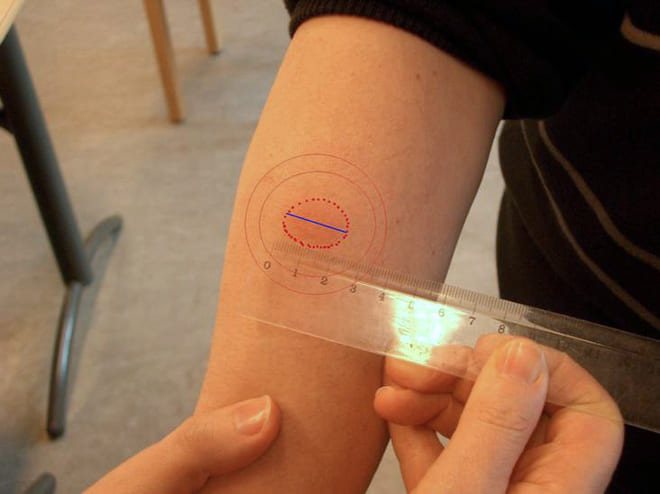
Hyperergic reaction
Since tuberculin itself consists of protein residues of destroyed Mycobacterium tuberculosis, preservatives and stabilizers, a nonspecific allergy may occur to these components of the solution. She has the following symptoms:
- swelling,
- itching,
- rashes,
- redness,
- irritation.
To eliminate them, drugs from the antihistamine group are used, including Suprastin.
We recommend reading about the causes of Mantoux allergy. From the article you will learn about what provokes the development of allergies to the Mantoux vaccine, who is more susceptible to allergies among children, what to do if allergy symptoms appear in a child. And here is more information about why the temperature may rise after Mantoux.
Allergy after Mantoux
An allergy after the introduction of tuberculin into the body may appear in the evening, on the day of the injection. If the child's reaction to Mantoux is normal and the button is properly cared for, there should not be an allergic reaction. The child continues to feel well, eats normally, sleeps and is awake. If you notice something unusual in the baby’s behavior or well-being, analyze:
- Has your child had any infectious diseases in the last month?
- Was he in contact with carriers of the disease (tuberculosis)?
- Does your child have a predisposition to allergies?
- Was the button cared for correctly?
An allergy after Mantoux may also occur because the substance that is introduced into the body, in addition to tuberculin, also contains phenol. This is a toxic substance. In small quantities, phenol is safe. But if your child is intolerant to this substance, you are guaranteed an allergy.
[5], [6]
Does taking Suprastin affect the test result?
Suprastin can only affect a nonspecific type of reaction. It develops within a few minutes. As a result of taking this antiallergic drug on the first day, the reaction to Mantoux may not be very pronounced.
The sample is assessed after three days. During this time, a specific reaction develops, which is not affected by the antihistamine. Suprastin will not change the size of the infiltrate.
After vaccination with BCG, lymphocytes remain in the child’s body - the so-called memory cells that can fight Koch’s bacillus. The production of these cells is the essence of formed immunity, that is, if they are absent, then there is no immunity against tuberculosis. When the body does not react to tuberculin in any way, it means that such lymphocytes are absent. In this case, revaccination is carried out.
When the Mantoux reaction is pronounced, it means that tuberculin has provoked the work of a large number of lymphocytes. If there are too many of them, the injection site becomes very swollen, other alarming symptoms appear, and the presence of a disease can be suspected. Then the patient will be sent for additional examination.
Suprastin before Mantoux reduces the likelihood of a false-positive result caused by a reaction to tuberculin or another component of the sample.

A false negative reaction is also possible if an allergy develops due to weakened immunity. In this case, you will need to consult a phthisiatrician who will prescribe an in-depth examination.
Symptoms of allergy to Mantoux
Symptoms of a Mantoux allergy in a child may occur suddenly. They can easily be confused with common prickly heat, shortness of breath, or a cold. But, be careful. Allergy after Mantoux may be accompanied by:
- high body temperature;
- skin rashes;
- loss of appetite;
- general muscle weakness;
- anaphylaxis.
Skin rashes may appear not only at the injection site or around it. Pimples, or even blisters, can appear on the most delicate areas of the skin - in the groin, on the butt, behind the knees, on the inside of the elbow and on the face. The skin may be dry, flaky, or itchy.
[7], [8]
Mantoux test for allergies
If the diagnosis is correct - an allergy to the Mantoux test - then the therapist may prescribe other methods for detecting tuberculosis infection. The Mantoux test for allergies is most often not performed, so as not to aggravate an existing one. If you want to find out if there is a tuberculosis infection in your child’s body, the tuberculosis dispensary will help you with the method of determination. You can do fluorography and sputum analysis. Mantoux is not a panacea. This is just the fastest method of preventing tuberculosis in children.
[9]
Treatment of allergy to Mantoux
Like any other allergy, an allergy to the Mantoux reaction cannot be cured. It is possible and necessary to stop this manifestation of the child’s body. If you decide to have another Mantoux test, make sure that your child takes antihistamines two or three days before the test. This could be the antihistamine Zyrtec, or Zodak. Taking one of these drugs will greatly facilitate the baby's reaction to Mantoux. Just do not forget to warn the doctors who will conduct the test about which antihistamine your child took. Your family doctor, therapist or allergist will help determine the dosage.
[10]
What to do if you are allergic to Mantoux?
If you notice any manifestations of allergies in your baby, rush to show him to the doctor. Moreover, if the child has not previously had an allergy to anything. The symptoms listed above may not match how your child's allergy manifests itself specifically. Children's bodies are so different that some may have a headache, and that's all, while others may have endless vomiting and insomnia. Your family doctor will tell you what to do if you are allergic to Mantoux. If this is not your first time experiencing an allergy, follow the instructions given to you by your doctor. First, rule out the possibility of “not allergies.” Headache due to TV, fever due to a cold, etc. Next, give the child half a Diazolin tablet. It will help relieve allergic reactions, even skin ones. If the allergy is accompanied by difficulty breathing, call an ambulance. And as soon as possible. There's no point in wasting time here.
What to do if a child is allergic to Mantoux?
If you are sure that your child is allergic to Mantoux, be careful. This means that the child is predisposed to a positive reaction to various allergens. It is worth consulting with an immunologist or allergist about the effects of other allergens.
Preparation for the procedure
The main condition for conducting a test for tuberculosis is the exclusion of possible contraindications, such as:
- infectious diseases during the course, as well as a month and a half after the illness;
- skin diseases during exacerbation;
- allergies, atopic dermatitis;
- epilepsy;
- manifestation of a violent allergic reaction when the child is given the first test - in this case, alternative diagnostic methods will be used.
In addition, it is unacceptable to do a tuberculin test at the same time as other vaccinations.
If there are other diseases, including chronic diseases, the decision on the possibility of conducting the test is made by the doctor. Thus, hydronephrosis - a kidney disease - will not be a contraindication to Mantoux.
If there are no contraindications, then the question of how to prepare a child for Mantoux will not cause difficulties: it is enough to follow a number of simple recommendations:
- A few days before the procedure, avoid visiting crowded places to avoid accidentally contracting a viral infection. It should be taken into account that the incubation period of the disease can last up to 10 days, and the Mantoux test against the background of the disease can provoke complications, in addition, it itself will most likely turn out to be uninformative. Immediately before the Mantoux test, the baby must be examined by a doctor and given permission to conduct the test.
- The child should be well-fed and calm at the time of the procedure; the baby should be given a good night's sleep. The diet for the week before the test date should be familiar; you should not introduce new foods at this time; it is better to avoid the consumption of foods and drinks that can cause allergies. If you are allergic to pollen from flowering plants, it is better to postpone the test a month before or after the flowering period.
- If a child is allergic, you need to make sure that at the time of the Mantoux reaction he does not have any allergic manifestations: the skin should be clean, without rashes and redness. For preventive purposes, such a patient can be given antihistamines 2-3 days before the tuberculin test (it is not recommended to use first-generation drugs, for example, suprastin; it is better to consult a pediatrician).
- Constipation at the time of the procedure can cause side effects, so parents need to make sure that the child’s intestines are free. Lactose will help improve intestinal function.
- On the day of the Mantoux reaction, it is necessary to minimize the child’s interaction with other children in the clinic. The best option is if the baby spends the waiting time on a walk. This measure is also aimed at preventing possible infection with acute respiratory infections or acute respiratory viral infections.
- After administering tuberculin, you need to observe the baby’s reaction for half an hour; during this time it is better not to go far from the clinic: if the child experiences any alarming reaction during this time, you should immediately consult a doctor.
- To avoid the child’s excessive attention to the injection site, it is recommended to choose clothes made from natural fabrics with long, loose sleeves. This will protect the “button” from unwanted friction and moisture.
After the Mantoux test is done, it is necessary to ensure the child a calm emotional state and a gentle daily routine, and avoid unnecessary physical and psychological stress. Nutrition should also remain familiar; it is better to prepare familiar food for the child without experimenting with the introduction of new products.
Prevention of allergy to Mantoux
Prevention of allergy to Mantoux is possible at home. Since the Mantoux test is a reaction of the immune system to an irritant, strengthen your child’s immunity. The healthier your baby is, the easier it will be for him to tolerate the Mantoux test. It would be reasonable to listen to the opinions of different doctors, an immunologist, a therapist, an allergist, about the need for a Mantoux test every year. After all, the best prevention of allergies is to eliminate the possibility of the allergen entering the body. In this case, the allergen is tuberculin. Check for tuberculosis in other ways, and you will protect your child from the possibility of allergies.
An allergy to Mantoux, nothing more than an ordinary allergy, can be stopped. Write to your local clinic, kindergarten, or school to refuse to perform the Mantoux test on your child. If you are at risk of contracting tuberculosis, get checked regularly at your local tuberculosis clinic. And check on your children.
[11]
Source
